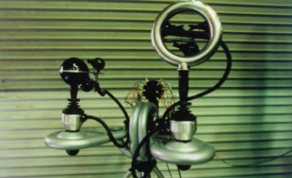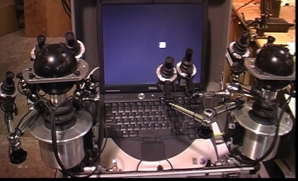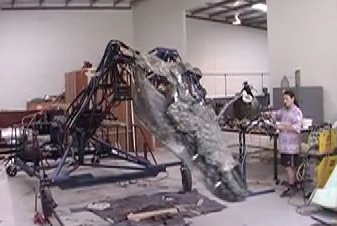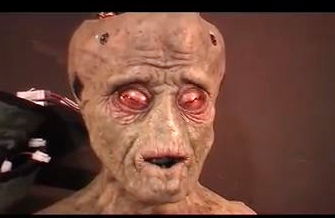




Absolute total control
Everyone loves a control freak right?
These are joystick input controls designed and built by Greg to control
complicated animatronic characters. The device on the left Greg designed for
MEG and allows one person to control a robotic face or whole character with up
to 64 individual movements at once to allow the spontaneous generation of
numerous facial expressions, and call up and mix any number of preset emotional
expressions and mix them together with any degree of nuance required. The
device on the right built for ICP and used on Starwars has 22 axies of digital
proportional input. Each Individual axis with computer controlled electronic
mixing can control over 64 individual servo motors or hydraulic rams.
One single axis of a joystick can be set up to control a vast number of motors
to pull a character’s face into a variety of expressions. Push up and the face grimaces, push down
and the face frowns.
Push another joystick to the left and the mouth forms a shape to pronounce an “OOOh”, the other way to form an “EEEE” etc.
However, even with such a sophisticated system, manually performing lip synch
will never produce results as effectively as prerecording and editing movements
untill they perfectly match a prerecorded vocal performance. This is the way
computer animated characters have their lip synch created and why it most often
looks very effective.
Unfortunately, films using animatronics often have puppeteers wiggle the
joysticks and shout out half finished dialogue themselves live on set, then
afterwards the film production has a voice actor record completely different
dialogue over the top. Not surprisingly the lipsynch ends up looking like a
badlydubbed hong kong action film.
The problem is not animatronics but the whole live performance and dubbing
procedure. If 3D animated characters have the actor’s voice recorded to changed dialogue after the animation is finished, the result
looks just as terrible.
By Pre-recording the dialogue and lipsynch, animatronics no longer look so “muppet like”.
Gilderfluke
A computer controlled performance editing and playback system Greg often uses is
Gilderfluke.
This software and electronics system is used in hydraulic motion base control
and theme parks worldwide. It allows Multiple axies of motion to be
electronically mixed and controllled by a single or multiple inputs, and the
resulting motions recorded for exact playback. Once a series of movements are
recorded, they can be graphically edited and modified untill the results are
exactly what is required.
Gilderfluke is excellent for setting up facial animation and recording and
perfecting a performance. That prerecorded performance can then be played back
on set with accurate lip synch every take. The movements can also be manually
over-ridden and modified live during a take for spontaneous interaction with
actors.

A Star Wars Character “Nute Gunray” in the process of lip synch programming by Greg and close to completion. Some
words are enunciated well and some still need more work. The Gilderfluke
programming system and graphical editing mean that you can take the time to
perfect lip synch before going on set.
Quicktime Video

This Hydraulic Croc built for John Cox and the Movie “Peter Pan” shows the “voodoo” control principle at work and Greg’s principle of “delayed precision” to give an organic quality of movement unlike ordinary hydraulics.
Beautiful engineering by Trevor Tighe.
Quicktime Video 23mb

It’s all Voodoo
Greg and the Robotech team pioneered the use of slave system controls for
complex animtronic characters years before the principle was adopted overseas.
Greg’s innovative designs for Kangaroo Kid from 1991 predate those glorified in
Jurassic Park. The miniature electronic analogues of robot characters work like
a voodoo doll. What the performer does to the Voodoo is exactly matched by the
animatronic character. No clumsy coordination of multiple performers.
Delayed Precision
To this Greg also added the philosophy of delayed precision. Mechanical robotics
and electronics systems are usually designed so that a movement will reach its
destination position in fractions of seconds and hold that position exactly.
The control signals travel down the wires at close to the speed of light. Servo
motors race to reach their destination and hold position rigidly. Mechanical
pivots are precise bearings. Not surprisingly, robotic systems look mechanical.
In Organic systems, signals travel down neurones at only the speed of sound, and
pivots are oily gristle and elastic tendons pulled by nervous, twitchy muscle.
Organic limbs get to round about a desired position quickly but may take almost
a second to reach a precise position.
For instance, hold your hands behind your head then quickly try to hold your
index fingers tip to tip a match head distance apart in front of you. It may
take a second or so for an organic system(you) to achieve this. By mimicing
this quality of delayed precision into a robotic animal, it appears far more
natural and oganic in its movements.




